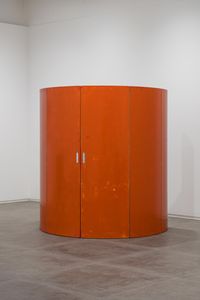
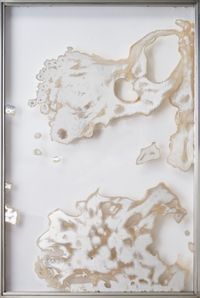
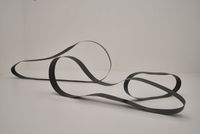
ONE AND J. Gallery presents an exhibition titled CASE STUDY #1: INSIDE THE HOUSE from 20 February to 10 March 2024. This exhibition features 26 pieces of exquisite furniture created by a master of 20th-century architecture, Le Corbusier (real name Charles-Édouard Jeanneret, 1887–1965), as well as Pierre Jeanneret (1896–1967), Charlotte Perriand (1903–1999), and Jean Prouvé (1901–1984), three associates of Le Corbusier with whom he maintained close relationships for many decades. These works were created from the 1920s throughout the 1960s, a period during which these four engaged in continual collaboration and exchange with one another. The exhibition also features three works including the early work by artist Suyoung Kim, which she created by observing buildings Le Corbusier designed and translating her resultant sensations and memories into painterly language. Visitors can also see six sculptures by artist Soyoung Chung that give physical form to the possibility of transformation in the context of space and the traces of memory emanating from the flow of time.
The title of this exhibition, CASE STUDY #1: INSIDE THE HOUSE, is derived from the 'Case Study Houses' programme, which redefined the image of modern living. This 'programme' involved 36 houses commissioned between 1945 and 1966 and built mainly in Los Angeles by architects who were contemporaries of Le Corbusier and had been influenced by him, and vice versa. This exhibition invites guests to experience this unfamiliar yet imaginative encounter between works of furniture imbued with the artistic spirit of pioneering figures who presented a new paradigm of modern furniture design as well as meaningful works from contemporary artists—all presented within the living space of the 'house'.
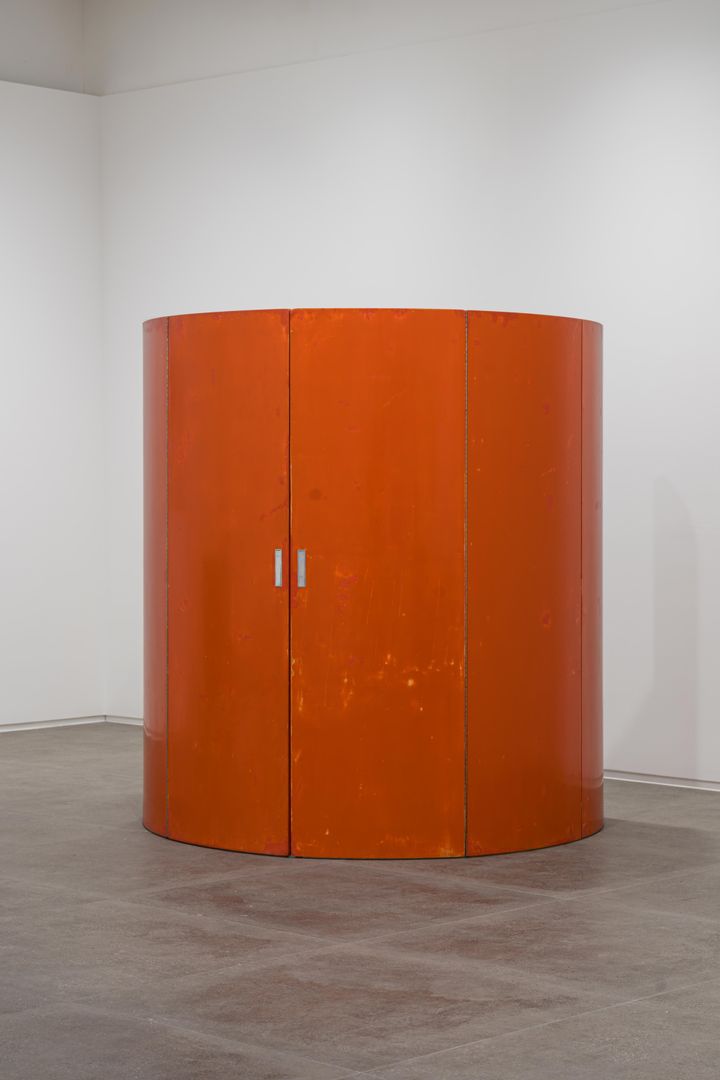
A house is a machine for living in. –Le Corbusier
In Le Corbusier's influential book Vers une architecture (Toward an Architecture)—which created an instant sensation among the architects of Europe upon its publication in France in 1923—he wrote, 'A house is a machine for living in.' This statement embodies Le Corbusier's philosophy and his life's work of developing an architecture 'for humans' meant to facilitate a new modern form of living. Sensing the new relevance of interior design resulting from the transformation of daily life brought about by the evolution of architecture, Le Corbusier designed furniture and interior design since 1905. Upon establishing an architecture studio in Paris in 1922, he started collaborating with Pierre Jeanneret, with whom he had maintained a close relationship. In 1927, Charlotte Perriand joined the studio, working together in collaboration. From 1929, Jean Prouvé, a founding member of the Union des artistes modernes (Union of Modern Artists), started designing furniture both independently and in collaboration with Le Corbusier, Jeanneret, and Perriand.
This exhibition features Le Corbusier's unique work A Pair of Screens/Room Dividers (c. 1952), which was originally from the Cité Radieuse in Marseille (1952), a housing complex designed by Le Corbusier that is registered as a UNESCO World Heritage site. The Screens, which are also referred to as 'room dividers,' are a unique creation that incorporates the geometrical vertical lines and curves that are typical of his architectural works. This work—which it seems was designed to enclose a small space like an alcove or a cupboard—was a special order placed by Lillette Rypert, a friend of Le Corbusier and the nursery school teacher at the Cité Radieuse. This Screens clearly differs from the room divider designs he had created previously, with its vivid orange colour highlighting its unique shape.
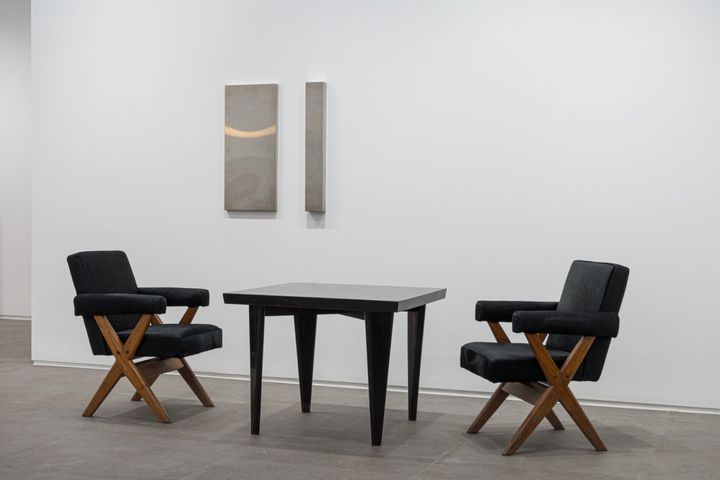
Pierre Jeanneret, who completed various architectural projects while maintaining an over 50-year collaborative relationship with Le Corbusier, was a progressive and pioneering architect and designer. In addition to architecture, Jeanneret also had an outstanding sense for furniture design, which led him to work and collaborate with Charlotte Perriand and Jean Prouvé. In 1951, at the invitation of Le Corbusier, he participated in the Chandigarh project in India, where for 15 years he lived in India while serving as a chief architect of the Chandigarh urban planning and construction project, which involved overseeing the construction of government offices, public buildings, and housing complexes, as well as a variety of furniture pieces for these spaces. This exhibition presents a collection of furniture showcasing Jeanneret's unique design, including a pair of 'X leg' armchairs, a file rack produced circa 1957, 'Square' table, and rare demountable low chair designed during the Chandigarh project.
The extension of the art of dwelling is the art of living. – Charlotte Perriand
In 1927, at a time when the art world was rather unwelcoming to women, Charlotte Perriand presented her Bar Sou Le Toit (Bar Under the Roof) at the Salon d-Automne, showcasing her elegant and sophisticated designs realised through an innovative use of aluminium, chrome and glass. This marked the beginning of a career that would eventually make her a leader of 20th-century French modernism. As a result of this success, she was able to join Le Corbusier's architecture studio that same year, and for ten years, she immersed herself in furniture and interior design alongside Pierre Jeanneret. This exhibition offers a new perspective on the LC4 Chaise longue, LC6 dining table, and LC7 chair, which were first shown at the exhibition Interior Design Equipment of a House at Salon d'Automne in 1929—a period during which these three were collaborating with one another. In 1940, she moved to Japan at the invitation of the Japanese Government to serve as a cultural advisor on industrial arts. She studied traditional Japanese culture, materials, and crafts, interpreting them from a modern sensibility. On this basis, she created benches, chairs, stools, and other works that have become representative of Perriand's style, all of which can be seen in this exhibition.
We must build beauty for every day and for everybody – Jean Prouvé
Legendary French architect and designer Jean Prouvé was a founding member of the Union des artistes modernes (Union of Modern Artists) in 1929 and engaged in continual exchange and collaboration with Le Corbusier, Jeanneret, and Perriand. Prouvé's practice encompassed a great variety of work, from furniture to large structures and even buildings, and he regularly contributed to Le Corbusier's architectural designs, such as researching prefabricated elements for Le Corbusier's architectural creations. With Jeanneret and Perriand, he collaborated on architecture and design projects and held joint exhibitions. This exhibition focuses on his various types of tables and chairs including Fauteuil Visiteur Kangourou FV 32 / Armchair, variant with double seat (c. 1948), Métropole No. 305 (c. 1950), S.A.M no. 502 table, and Cafétéria" guéridon, model no. 511.
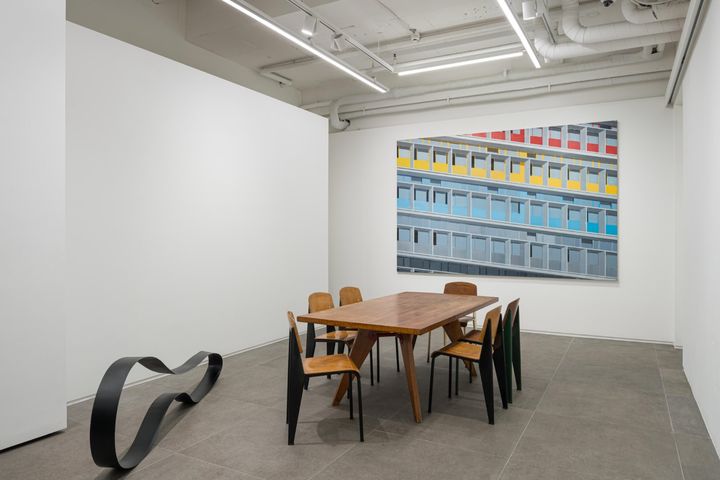
I attempt to represent the abstractness of the city where my daily life plays out as a landscape. – Suyoung Kim, 2024
Artist Suyoung Kim has continually experimented with painting throughout her career. In the early 2000s, while studying abroad in Germany, she began painting works of modern buildings that had become part of the fabric of everyday life in Europe. After returning to Korea, she continued her work of translating the abstract features of modern European architecture into the language of painting, but this time using collage to express the everyday landscape of Korean urban spaces. Her early works, in particular, feature a plethora of buildings by Le Corbusier, which intrigued Suyoung Kim for their novel sense of rhythm. This exhibition presents her work Cité du Refuge (2004), which is a painting of an actual work of architecture. Suyoung Kim created the work based on her sensations and memories of having observed a building over a long period of time. The work takes its name from the first housing project designed by Le Corbusier, Cité du Refuge, which was completed in 1933. In both a realistic yet abstract manner, the work captures the painted squares of the windows and the repeating modules that are typical of Le Corbusier's architectural language. When viewed together in the gallery space with Le Corbusier's Screens, the viewer experiences the subtle flow of sensations that vacillates between three- and two-dimensional planes. Another early work titled Weisshof Sett (2003) is being shown in Korea for the first time; this painting depicts the architectural works of German architect Peter Behrens. Painted in restrained colours, the work is simple yet displays a balanced sense of proportion. Her Work No. 71 (2021), which was made while living in Korea, creates a montage out of various domestic and overseas architectural elements, including parts of tiles, walls, and buildings, and is one of her 'Work' series that has been ongoing since 2012.
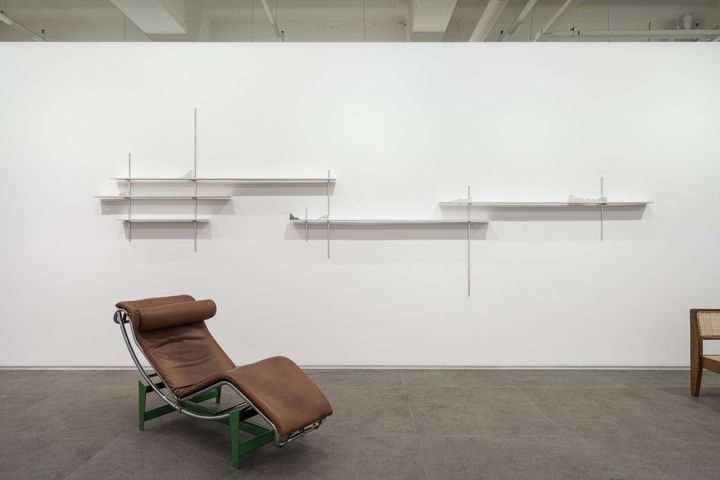
I believe the past would rather give room for imagination.... The future does not give you time and space to turn your head in another direction to stare at something else. – Soyoung Chung, 2020
Artist Soyoung Chung's work involves giving form to the long history of geological time. For this exhibition, Soyoung Chung presents works of sculpture that give shape to the fundamental layer of time, as well as the multi-layered relationships and boundaries existing in the relationship between history and space–time. Rolling (2020–2021) is a work that swims between matter while riding the flow of time. It is a work that encompasses the trajectory of history rolling between the divisions of nature created by the process of occupation and the ecosystem. Her work 29.5 Days (2021–2023), which is installed against a long wall, records traces of time created by the gravitational pull of the Earth and Moon. In this way, it reveals a phenomenon generated by the simultaneous presence of two completely different forces. This is a recent work that builds on a previous artwork presented at a solo exhibition at ONE AND J. Gallery in 2021 titled Sea Cucumber, Manganese and Ear. Although this new work is larger in size, it achieves a more delicate expression than the previous work. Meanwhile, her series Mirror for Mirok Yi (2021–2022), which visualises the creation and extermination of nature as it is constructed and transformed within human time, presents a discontinuous sequence of time. Through this work—which was inspired by the book The Yalu Flows by Mirok Yi (1899–1950), who fled to Europe through Manchuria during Japanese colonial times—artist Soyoung Chung manipulates form to interrogate how memories are formed and reformed within the flow of time.
Press release courtesy ONE AND J. Gallery. Curated by Bokyoung Yun.
26, Apgujeong-ro 60-gil
Gangnam-gu
Seoul, 06014
South Korea
www.oneandj.com
+82 2 745 1644
+82 2 745 1642 (Fax)
Tuesday – Sunday
11am – 6pm